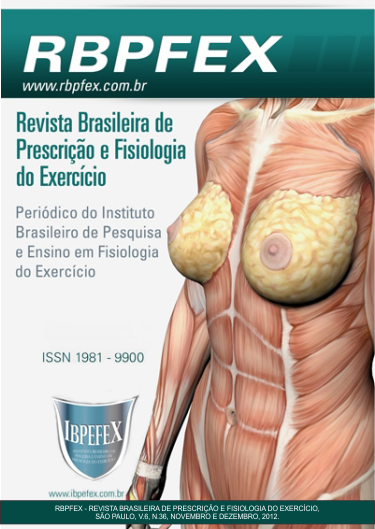Investigation of anthropometric profile of practiitioners of walking and running
Abstract
Although obesity is ancient, in the current century it seems that an increasing concern with such disease is more present, perhaps due to the lack of studies that could in that time correlate it with the hazard to health, so being fat was healthy. This research aimsto design the fat profile of people who exercise with walks in public squares, from 18-90 years-old, independently from gender. The research is a profile, standard, type, descriptive, correlational study and data collection was accomplished from the application of a survey and a “Physical Evaluation Chart”. Sample was composed of 206 subjects who practiced regular walk/jogging in public squares of Fortaleza, at 6 A.M. to 9 A.M.. The study shows that 41.7% of the sample have mild obesity or overweight and that 15.1% have moderate obesity. The health risk factor measured from abdominal circumference detected a very increased risk (37.4%) and an increased risk (28.2%). In contrast with waist-t-hip ratio, the study found a very high risk (38.8%) and a high risk(31.1%). Cutaneous adiposity profile was 24.8% classified as very bad and 21.8% as bad. Results show a prevalence of mild obesity and overweight among individuals who practice walking/jogging, with very increased health risk. In contrast with waist-t-hip ratio, the study found very high risk. Cutaneous adiposity percentile was classified as very bad.
References
-Afonso, F.M.; Schieri, R. Associação do índice de massa corporal e da relação cintura/quadril com hospitalizações em adultos do Município do Rio de Janeiro, RJ. Rev. bras. epidemiol. Vol. 5. Núm. 2. 2002.
-Assis, C.R.; Mesa, Â.J.R.; Nunes, V.G.S. Determinação da Composição Corporal de Pessoas de 20 a 70 anos, da Comunidade Pelotense. Revista Brasileira de Cineantropometria & Desempenho Humano. Vol. 1. Núm. 1. p. 82-88. 1999.
-Barra, M.G.B.; Biesek, S.; Fernandes, A.T.P.; Araújo, C.G.S. Comparação do Padrão de Atividade Física e Peso Corporal Total de egressos e Atuais entre Graduandos e Mestres em Educação Física. Revista Brasileira em Ciência do Esporte. Vol. 21. Núm. 2. p. 30-35. 2000.
-Castanheira, M.; Olinto, M.T.; Petrucci, A.; Gigante, D. Associação de variáveis sócio-demográficas e comportamentais com a gordura abdominal em adultos: estudo de base populacional no Sul do Brasil Cad. Saúde Pública. Rio deJaneiro. Vol. 19. Sup. 1. p. S55-S65. 2003.
-Garn, S.M.; Clark, D.C. Trends in fatness and the origins of obesity. Pediatrics. Núm. 57. p. 443-456. 1976.
-Katch, F.I.; McArdle, W.D. Fisiologia do Exercício, Nutrição e Desempenho Humano, 5Edição. Manole. 2003.
-Lohman, T. G.; Roche, A. F.; Martorell, R. Anthropometric Standardization Reference Manual. Illinois.Human Kinetics Books.1988.
-Lamounier, J. A.; Abrantes, M. M.; Colosimo, E. A. Prevalência de Sobrepeso e obesidade Nas Regiões Nordeste e Sudeste do Brasil. Revista Associação Médica Brasil. Vol. 2. Núm. 49. p. 162. 2003.
-Lamounier, J. A.; Ribeiro, R.Q.C.; Oliveira, R.G.; Colosimo, E.A.; Bogutchi, T.F. Prevalência da obesidade em escolares adolescentes na cidade de Belo Horizonte. Resultados parciais do II Estudo Epidemiológico. Anais do Simpósio: Obesidade e anemia carencial na adolescência. Instituto Danone. p. 237-238. 2000.
-Moraes, R. Nível socioeconômico determina hábitos que desencadeiam a obesidade. São Paulo.02/09/2005-Boletim no. 1701. Agência USP Notícia. Disponível emhttp://www.usp.br/bols/2005/rede1701.htm
-NAHA National Institutes of Health and National Heart, Lung, and Blood Institute. Clinical Guidilines on the identification, evaluation, and treatment of overweigth and obesity in adults. The Evidence Report. Obesity Research. Vol. 6. Suppl 2. 1998.
-Pollock, M.L.; Wilmore, J.H. Exercícios na Saúde e na doença, avaliação e prescrição para a prevenção e reabilitação. 2ªedição. Ed. Medsi. 1993.
-Repetto, G. Histórico da Obesidade. In Halpen, A.; Godoy, A. F.; Suplicy, H. L. Ruiz.; A. T.;Ruiz, J.V.T. Aspects Pratics del Tratctament de I ́Obesitst Infantil. APUNTS. Vol. 30. p. 17-34. 1993.
-Santos, R.D.; Timerman, S.; Spositi, A.; Excesso de peso no Brasil- o fator de risco no novo milênio. In: Diretrizes Para Cardiologia Sobre Excesso de Peso e Doença Cardiovascular dos Departamentos de Aterosclerose, Cardiologia Clínica e FUNCOR da Sociedade Brasileira de Cardiologia. Arquivo Brasileiro de Cardiologia. Vol. 1. Núm. 78. 2002.
-World Health Organization. Obesity-Preventing and managing the global epidemic. Report of a WHO consultation on obesity. Geneva: World Health Organization. 1988. Disponível em: www.who.int/nut/documents/pr32_pt.pdf
-World Health Organization. The Asia Pacific perspective: Redefining obesity and its treatment. 2000. Disponível em:http://www.wpro.who.int/nutrition/documents/docs/Redefiningobesity.pdf Acessado em 09/10/2003.
Authors who publish in this journal agree to the following terms:
- Authors retain the copyright and grant the journal the right of first publication, with work simultaneously licensed under the Creative Commons Attribution License BY-NC which allows the sharing of the work with acknowledgment of the authorship of the work and initial publication in this journal.
- Authors are authorized to enter into additional contracts separately for non-exclusive distribution of the version of the work published in this journal (eg, publishing in institutional repository or book chapter), with acknowledgment of authorship and initial publication in this journal.
- Authors are allowed and encouraged to post and distribute their work online (eg, in institutional repositories or on their personal page) at any point before or during the editorial process, as this can bring about productive change as well as increase impact and impact. citation of published work (See The Effect of Free Access).






